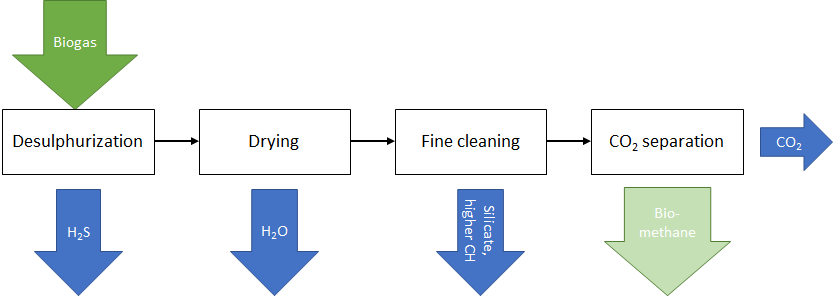8. Biogas production
8.4 Possible applications of biogas
There are two possible uses for biogas:
1. direct energy use
The biogas is burned directly in a combined heat and power plant (CHP) without pre-cleaning. In a CHP unit, the resulting energy is first converted into mechanical energy using the principle of a combustion engine and then into electrical energy in a generator. In addition, the resulting heat can be used to provide space heating, for example.
2. use in the form of biomethane
Biogas can be converted into biomethane (preferably pure methane gas) using purification processes. When converting biogas into biomethane, various impurities must be separated. The sequence of the individual purification steps is shown schematically in the following diagram.

1st step = hydrolysis:
The sequence of these conversion steps is not fixed and can vary depending on the process used.
During desulphurization, the hydrogen sulphides are first separated from the gas flow. These can be removed biologically via aerobic sulphur bacteria or chemically via a chemical reaction with the addition of sulphur-binding substances or by chemical binding to the surfaces of surface-active solids (so-called adsorption).
The biogas can be dried, for example, by refrigeration drying (also known as condensation drying), whereby the water precipitated by the cooling of the gas flow is removed.
The separation of higher hydrocarbons, as well as dust and silicates, is referred to as fine purification. This separation can be achieved by using activated carbon in a fixed bed reactor.
In the final step, CO2 is separated from the biogas stream. Usually, the CO2 was then emitted into the atmosphere. However, the demand for green CO2 has been growing in recent years for a variety of applications, such as applications in greenhouses, in the beverage industry and in the chemical sector. It can therefore be assumed that CO2 will continue to be utilized in the future.
There is also the possibility of converting CO2 into methane using chemical or biological processes in order to increase the biomethane yield.
The gas stream remaining after CO2 capture then consists of almost pure methane, which can be used for material or energy purposes.